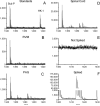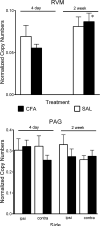Changes in the disposition of substance P in the rostral ventromedial medulla after inflammatory injury in the rat
- PMID: 26762802
- PMCID: PMC4738059
- DOI: 10.1016/j.neuroscience.2015.12.054
Changes in the disposition of substance P in the rostral ventromedial medulla after inflammatory injury in the rat
Abstract
This study examined whether peripheral inflammatory injury increases the levels or changes the disposition of substance P (SubP) in the rostral ventromedial medulla (RVM), which serves as a central relay in bulbospinal pathways of pain modulation. Enzyme immunoassay and reverse transcriptase quantitative polymerase chain reaction were used to measure SubP protein and transcript, respectively, in tissue homogenates prepared from the RVM and the periaqueductal gray (PAG) and cuneiform nuclei of rats that had received an intraplantar injection of saline or complete Freund's adjuvant (CFA). Matrix-Assisted Laser Desorption/Ionization Time of Flight analysis confirmed that the RVM does not contain hemokinin-1 (HK-1), which can confound measurements of SubP because it is recognized equally well by commercial antibodies for SubP. Levels of SubP protein in the RVM were unchanged four hours, four days and two weeks after injection of CFA. Tac1 transcripts were similarly unchanged in the RVM four days or two weeks after CFA. In contrast, the density of SubP immunoreactive processes in the RVM increased 2-fold within four hours and 2.7-fold four days after CFA injection; it was unchanged at two weeks. SubP-immunoreactive processes in the RVM include axon terminals of neurons located in the PAG and cuneiform nucleus. SubP content in homogenates of the PAG and cuneiform nucleus was significantly increased four days after CFA, but not at four hours or two weeks. Tac1 transcripts in homogenates of these nuclei were unchanged four days and two weeks after CFA. These findings suggest that there is an increased mobilization of SubP within processes in the RVM shortly after injury accompanied by an increased synthesis of SubP in neurons that project to the RVM. These findings are consonant with the hypothesis that an increase in SubP release in the RVM contributes to the hyperalgesia that develops after peripheral inflammatory injury.
Keywords: hemokinin-1; hyperalgesia; inflammation; neurokinin-1 receptor; rostral ventromedial medulla; substance P.
Copyright © 2016 IBRO. Published by Elsevier Ltd. All rights reserved.
Figures




Similar articles
-
Increased neuronal expression of neurokinin-1 receptor and stimulus-evoked internalization of the receptor in the rostral ventromedial medulla of the rat after peripheral inflammatory injury.J Comp Neurol. 2014 Sep 1;522(13):3037-51. doi: 10.1002/cne.23564. J Comp Neurol. 2014. PMID: 24639151 Free PMC article.
-
Effects of neurokinin-1 receptor agonism and antagonism in the rostral ventromedial medulla of rats with acute or persistent inflammatory nociception.Neuroscience. 2010 Feb 3;165(3):902-13. doi: 10.1016/j.neuroscience.2009.10.064. Epub 2009 Nov 3. Neuroscience. 2010. PMID: 19892001 Free PMC article.
-
Loss of neurons in rostral ventromedial medulla that express neurokinin-1 receptors decreases the development of hyperalgesia.Neuroscience. 2013 Oct 10;250:151-65. doi: 10.1016/j.neuroscience.2013.06.057. Epub 2013 Jul 3. Neuroscience. 2013. PMID: 23831426 Free PMC article.
-
Cell type-specific dissection of sensory pathways involved in descending modulation.Trends Neurosci. 2023 Jul;46(7):539-550. doi: 10.1016/j.tins.2023.04.002. Epub 2023 May 9. Trends Neurosci. 2023. PMID: 37164868 Free PMC article. Review.
-
Bulbospinal nociceptive ON and OFF cells related neural circuits and transmitters.Front Pharmacol. 2023 Apr 20;14:1159753. doi: 10.3389/fphar.2023.1159753. eCollection 2023. Front Pharmacol. 2023. PMID: 37153792 Free PMC article. Review.
Cited by
-
Probucol Ameliorates Complete Freund's Adjuvant-Induced Hyperalgesia by Targeting Peripheral and Spinal Cord Inflammation.Inflammation. 2019 Aug;42(4):1474-1490. doi: 10.1007/s10753-019-01011-3. Inflammation. 2019. PMID: 31011926
-
Hyperalgesia and sensitization of dorsal horn neurons following activation of NK-1 receptors in the rostral ventromedial medulla.J Neurophysiol. 2017 Nov 1;118(5):2727-2744. doi: 10.1152/jn.00478.2017. Epub 2017 Aug 9. J Neurophysiol. 2017. PMID: 28794197 Free PMC article.
-
Medullary kappa-opioid receptor neurons inhibit pain and itch through a descending circuit.Brain. 2022 Jul 29;145(7):2586-2601. doi: 10.1093/brain/awac189. Brain. 2022. PMID: 35598161 Free PMC article.
-
Plasticity in the Link between Pain-Transmitting and Pain-Modulating Systems in Acute and Persistent Inflammation.J Neurosci. 2019 Mar 13;39(11):2065-2079. doi: 10.1523/JNEUROSCI.2552-18.2019. Epub 2019 Jan 16. J Neurosci. 2019. PMID: 30651329 Free PMC article.
References
-
- Baranauskas G, Nistri A. Sensitization of pain pathways in the spinal cord: cellular mechanisms. Prog Neurobiol. 1998;54:349–365. - PubMed
-
- Beitz AJ. The nuclei of origin of brain stem enkephalin and substance P projections to the rodent nucleus raphe magnus. Neuroscience. 1982;7:2753–2768. - PubMed
-
- Berger A, Paige CJ. Hemokinin-1 has Substance P-like function in U-251 MG astrocytoma cells: a pharmacological and functional study. J Neuroimmunol. 2005;164:48–56. - PubMed
-
- Borbely E, Hajna Z, Sandor K, Kereskai L, Toth I, Pinter E, Nagy P, Szolcsanyi J, Quinn J, Zimmer A, Stewart J, Paige C, Berger A, Helyes Z. Role of tachykinin 1 and 4 gene-derived neuropeptides and the neurokinin 1 receptor in adjuvant-induced chronic arthritis of the mouse. PLoS One. 2013;8:e61684. - PMC - PubMed
Publication types
MeSH terms
Substances
Grants and funding
LinkOut - more resources
Full Text Sources
Other Literature Sources
Medical
Miscellaneous

